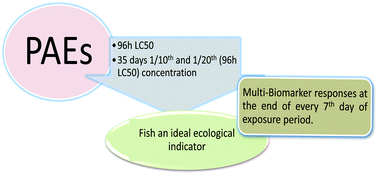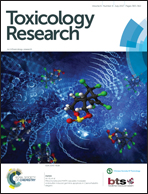Potential effects of low molecular weight phthalate esters (C16H22O4 and C12H14O4) on the freshwater fish Cyprinus carpio
Abstract
The aim of the present study is to assess the toxic effect of dibutyl phthalate (DBP) and diethyl phthalate (DEP) on the freshwater fish Cyprinus carpio. The median lethal concentrations of DBP and DEP for 96 h are found to be 35 and 53 mg L−1, respectively. Fish were exposed to 3.5 mg L−1 (Treatment I) and 1.75 mg L−1 (Treatment II) of DBP and 5.3 mg L−1 (Treatment I) and 2.65 mg L−1 (Treatment II) of DEP for a period of 35 days. The DBP and DEP exposed fish show a concentration based toxic effect on the selected parameters of this study. The hematological parameters, such as hemoglobin (Hb), hematocrit (Hct) and erythrocyte (RBC), were found to decrease in the DBP and DEP treated fish, whereas their leucocyte (WBC) count increased compared to that of the control groups. A biphasic response is noted in the erythrocyte indices, such as mean cellular volume (MCV), mean cellular hemoglobin (MCH) and mean cellular hemoglobin concentration (MCHC), throughout the study period. Exposure to DBP and DEP caused a significant (p < 0.05) decrease in sodium (Na+), potassium (K+), and chloride (Cl−) levels in the gill and brain of the fish throughout the study period when compared to that of their respective controls. The plasma protein level decreased in all the treatments, whereas the plasma glucose level significantly increased in the DBP and DEP exposed fish. Maximum inhibition of Na+/K+-ATPase activity was noticed in the gill and brain of the fish exposed to DBP and DEP. The cholinesterase (ChE) activity in the brain of the fish significantly decreased throughout the study period. A significant (p < 0.05) increase in glutamate oxaloacetate transaminase (GOT) and glutamic pyruvate transaminase (GPT) activity was noted in the fish exposed to both toxicants. The antioxidant enzymatic parameters such as superoxide dismutase (SOD) and catalase (CAT) activities were found to decrease in the gill and liver of the DBP and DEP treated fish, whereas a significant (p < 0.05) increase in lipid peroxidation (LPO) was observed. The above mentioned parameters could be used as potential biomarkers in clinical trials for the assessment of plasticizers. This study provides indispensable information towards future research on the effect of plasticizers on non-target organisms including humans.



 Please wait while we load your content...
Please wait while we load your content...